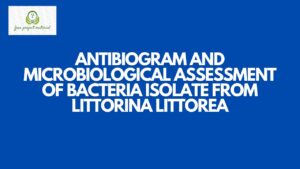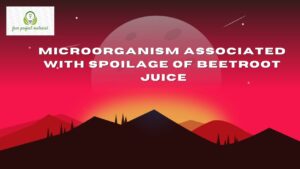ABSTRACT
The bacteriological quality of some local snacks sold in Ikot Ekpene metropolis was carried out using standard aseptical methods. The result of the study revealed that sample A had the highest bacterial count of 1.98×107 cfu/g while sample B had 1.35×107 cfu/g. The bacterial isolates were Streptococcus sp, Pseudomonas sp, Staphylococcus sp and Bacillus sp. with Staphylococcus sp having the highest percentage frequency occurrence of 38.7%, followed by Bacillus sp (35.7%), followed by Streptococcus sp (14.9%) and Pseudomonas sp with the least (10.7%). The total bacterial counts obtained in this study was higher than the WHO standard of <105 cfu/g. this suggest that the snacks could pose and health risk to consumers on continued consumption and consequently lead to food borne outbreak. It is recommended that awareness campaign should be carried out to educate the major players in the snacks industry on the approach of food safety management, management, associated vending hazards and critical points to be monitored so as to create consumers confidence and safety of the consumed snacks.
TABLE OF CONTENT
Title page – – – – – – – – – i
Certification – – – – – – – – ii
Dedication – – – – – – – – – iii
Acknowledgement – – – – – – – iv-v
Abstract – – – – – – – – – vi
Table of content – – – – – – – – vii-ix
CHAPTER ONE
1.0 INTRODUCTION – – – – – – – 1-2
1.1Background of the study – – – – – – 2-5
1.3 Aim and Objectives of the study – – – – – 5
1.2Scope and Limitation – – – – – – – 5-6
1.4 Definition of Terms – – – – – – – 6
CHAPTER TWO
LITERATURE REVIEW – – – – – – 7-9
2.1 Types of snack foods in Nigeria – – – – – – 9-10
2.1.1Tapioca – – – – – – – – 10-12
2.1.2 Kuli kuli – – – – – – – – 12-13
2.1.3Abacha – – – – – – – – 13-14
2.1.4 Melon seed cake – – – – – – – 14-15
2.2 Nutritional value of Local Snacks – – – – – 15-16
2.3 Potential Sources of Contamination of ready – to –eat (snack) – 16
2.3.1 Quality of Ingredient – – – – – – 16-17
2.3.2 Contaminated Food Process Chain – – – – 17-19
2.3.3 Unhygienic vending precision and condition – – – 19-20
2.4 microorganism associated with Ready-to –eat food (snack) – 21-23
2.5 Food safety solution to Ready –to –eat food (snack) – – 24-30
CHAPTER THREE
MATERIAL AND METHOD
3.1 Sample Collection – – – – – – – 31
3.2 Sterilization of glassware and media – – – – 31-32
3.3 Preparation of Samples – – – – – – 32
3.4 Bacteriological analysis of samples – – – – 32
3.4.1 Serial Dilution – – – – – – – 32-33
3.4.2 Inoculation of isolates – – – – – – 33
3.4.3 Enumeration of Isolates – – – – – – 33
3.4.4 Purification of Isolates – – – – – – 34
3.4.5 Characterization and Identification of Isolates – – 34
CHAPTER FOUR
RESULTS AND DISCUSSION
4.1Results – – – – – – – – – 35-37
4.2 Discussion – – – – – – – – 38-41
CHAPTER FIVE
5.0 CONCLUSION AND RECOMMENDATIONS
5.1 Conclusion – – – – – – – – 42
5.2 Recommendations – – – – – – – 42-43
References
CHAPTER ONE
1.0 INTRODUCTION
A snack is a portion of food smaller than a regular meal, generally eaten between meals. Snacks comes in a variety of forms including packaged snacks foods and other processed food, as well as items made from fresh ingredients at home. Consumption of snacks has become an integral part of convenient food preparation pattern all over the world including Nigeria. the most popular snacks consumed and sold in Nigeria are meat pic, sausages, doughnut, fish roll, egg roll, hamburger and so on. The consumption of snacks has bee reported to be associated with serious health problems and hazards (Adams and Moss, 2000). In developing countries such as Nigeria, a large proportion of ready to eat foods are sold on streets (Mensah et al., 2002). Fast food has already become a common feature of urban life with the increasing pace of globalization and tourism (Samuel, 2020). The safety of fast food has become a major concerns of public health (FAO/WHO, 2005). The health issue in both developed and developing countries. The global incidence of food borne diseases is difficult to estimate but it has been reported that in 2005 alone 1.8 million people diet from diarrhea disease. This cases can be attributed to contamination of food and drinking water (WHO, 2007). There is commonly a lack of information on the incidence of food borne disease related to fast food. Due to lack of proper knowledge and guidance, vendors prepare food in unhygienic conditions (Oranusi, 2012). ready-to-eat foods are most times exposed to air and dust and often stored at unsuitable temperatures which causes bacteria growth (Oranusi et al., 2013).
The aim of the study is to determined the sanitary quality of ready-to-eat snacks sold in fast food restaurant and road side sellers/outlets.
1.1 Background of the Study
In Nigeria today, most people depend on snacks for a significant portion of their nutritional requirements. This is common among young generations – the youth (single students) with our young ladies occupying the great proportion of this class. A snack is seen in western culture as a type of food not meant to be eaten as a mean meal of the day like breakfast, lunch or dinner but rather to assuage a person’s hunger between meals, providing a brief supply of energy for the body. Snacks are ready-to-eat food, raw or cooked, hot or chilled but ready for immediate consumption at the point of sale without further treatment. Ready-to-eat are foods that are consumed in the same state as they are sold which include dried meat, fish and cereal based ready-to-eat food and do not include nuts in the shell, whole raw fruits and vegetables that are intended for hulling, peeling or washing by the customers. Snacks are popular articles of diet because they are appetizing in appearance, convenient in form, nutritious I content and give pleasing fullness to the stomach when consumed. The preparation and sale of street foods is an age-old activity. Street foods are being served quickly, also tasty and it is available at reasonable rates. It attracts all the age groups, especially the younger generations.
The street food industry plays an important role in meeting the food requirements of urban dwellers in many cities and towns of developing countries. The industry foods millions of people daily with a wide variety of food that are relatively cheap and easily accessible. Recently food borne illness emanating from street foods has become a major health challenge. The traditional processing methods used in preparations, inappropriate holding temperature and poor personal hygiene of food handlers; these snacks are mostly displayed on open yards which can easily contaminated by dust, insects, exhaust smoke, hands of intending buyers and climatic elements which all lead to contamination of street vended foods.
Generally snacks are divided into continental and local. Continental snacks include, sandwiches, hotdogs, meat pies, salad, doughnuts and other bakery products while local snacks include roasted corn, potato chips, roasted plantain (‘booli’), plantain chips, fried maize past, kuli kuli, abacha, tapioca, melon seed cake and so on. However, some of these continental snacks like meat pie, fish pie have been locally imitated, adulterated and produced, hence they are easily vended locally because of their huge market acceptance. Meat or fish pie is a savory pie made of flour which contains meat or fish fillings and vegetables in it. Baked foods are perishable foods with a short shelf life and they need special care in handling. Plantain and patotoe chips are prepared by washing the fruits, peeling, slicing, slating and frying the sliced fruits in hot edible oil. Thereafter, the fried sliced fruits are packaged I potable and transparent nylon bags, ready for sale.
Therefore, this study is targeted to assess the bacteriological quality of some locally prepared snacks sold in Ikot Ekpene metropolis, Akwa Ibom State, Nigeria.
1.2 Aim and Objectives of the Study
The aim of this study is to determine the bacteriological quality of some local snacks sold in Ikot Ekpene metropolis as the objectives are;
- To determine the bacteriological quality of some local snacks.
- To isolate and identify bacteria present in the snack
- To give recommendations on the proper manufacturing process.
1.3 Scope and Limitation
The scope of this research work is to determine the bacteriological quality of some local snacks sold in Ikot Ekpene metropolis and the factors limiting this work was time and financial constraint and lack of adequate facility and good working environment.
1.4 Definition of Terms
Snack: A snack is a small portion of food generally eaten between meals. Snacks come in variety of forms including packaged snack foods and other processed foods as well as items made from fresh ingredients at home.
Bacteriology: is a branch and specialty of biology that studies the morphology, ecology, genetics and biochemistry of bacteria as well as many other aspects related to them. This subdivision of microbiology involves the identification, classification and the characterization of bacterial species.
Quality: the standard of something as measured against other things of similar kind, the degree and excellence of something.
Local: This is relating or restricted to a particular area or one’s neighbourhood. Another term for local can be regional.



